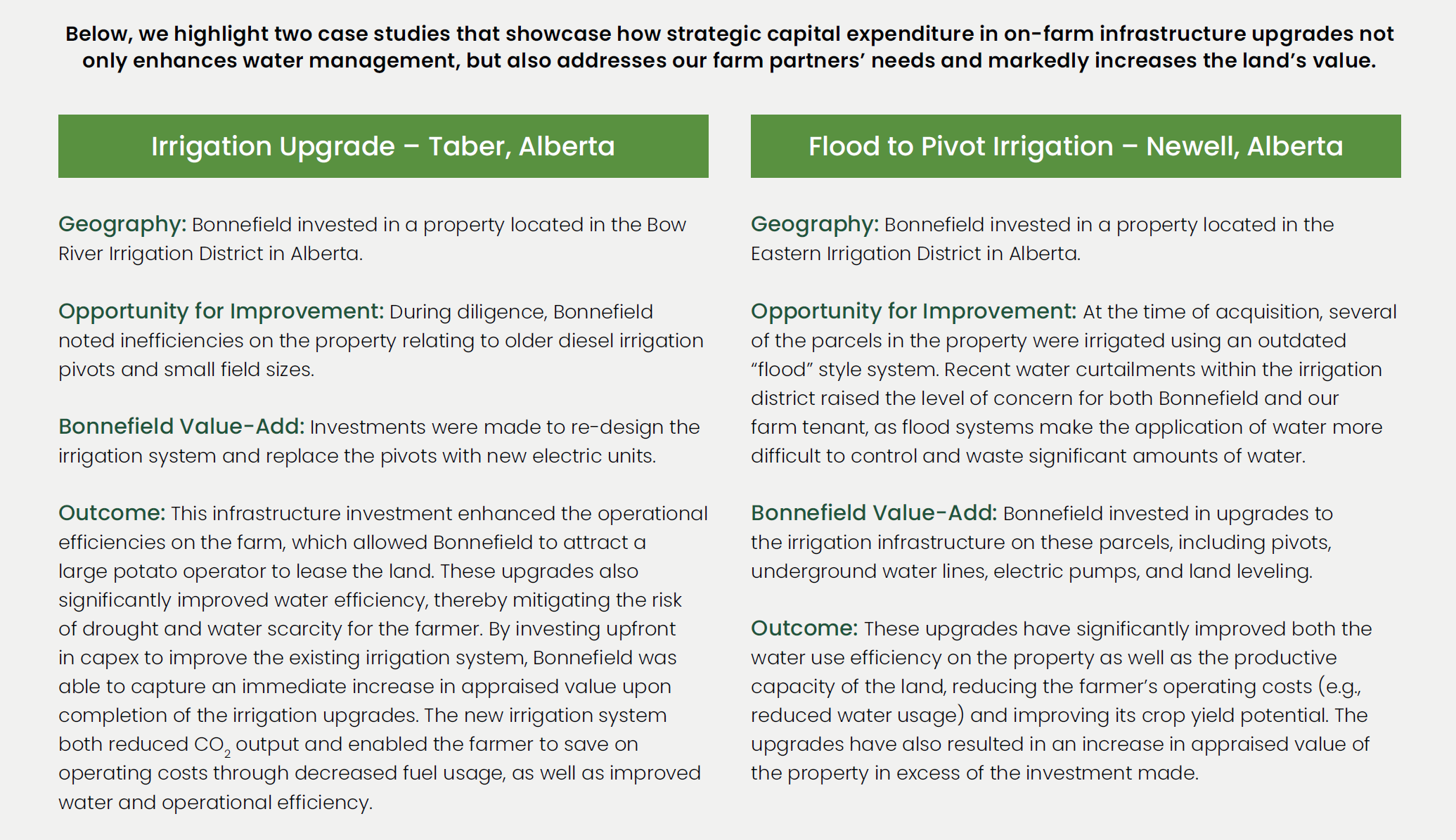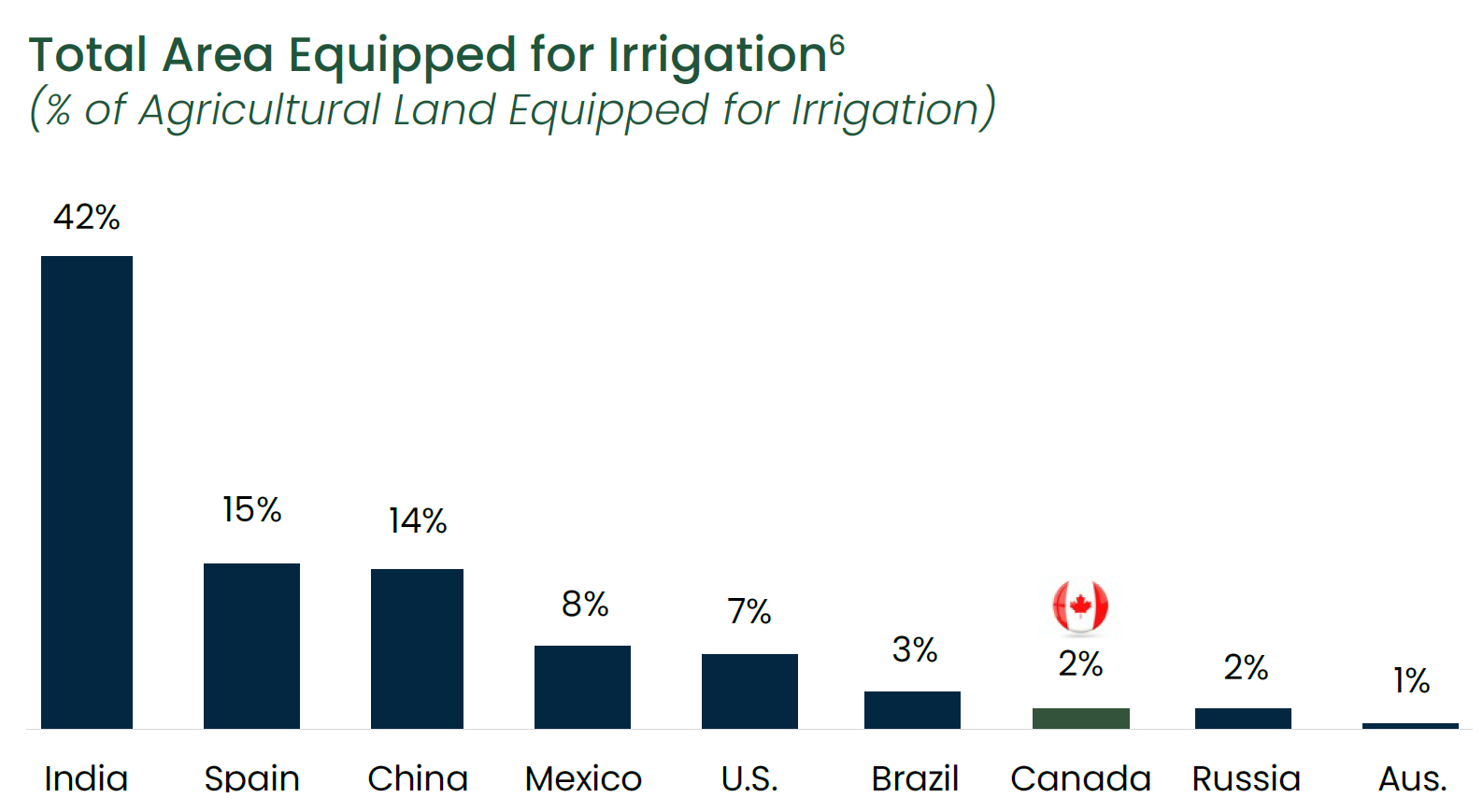Download PDF
Beneath the Surface: Canadian Drought Reality & Farmland Resilience
After a year marked by wildfires and continued global concerns over water scarcity, the headlines at the beginning of the 2024 growing season across North America, Europe, and South America have included discussion of drought risk and water availability. As a leading Canadian farmland and agriculture investment manager, Bonnefield is regularly asked whether such headlines signal increasing risks associated with investing in agriculture and farmland. The short answer is – it depends.
Geography and ongoing farmland management practices impact the relative risk that drought and water availability have on a farm’s operations. So, whether thinking about buying a single farm, or investing in a portfolio of pooled farmland assets, it is important to consider these factors in determining the relative risk that water availability has on the future operations of the farm(s) and on their long-term performance.
Geography and Canada’s Water Advantage
While increasing numbers of sophisticated investors are interested in gaining exposure to the attractive attributes of farmland and agriculture, as with everything, there are risks that need to be considered. Water scarcity is a major challenge for agricultural systems around the world and shifting climate patterns along with existing water management practices globally demand our attention. Research suggests that 40% of global croplands have already experienced water scarcity.(1) Agriculture remains one of the largest users of water globally, accounting for 70% of current global water withdrawals.(2)
When evaluating a potential farmland investment, it is important to consider geography, as certain countries are experiencing (and expected to continue to experience) greater water stress than others. For this reason, Bonnefield feels that investment in Canadian farmland entails less water-scarcity risk than investment in other countries, and can also hedge against water risk in a broader investment portfolio.
Canada boasts a significant water resource advantage relative to other parts of the globe, with approximately 20% of the world’s freshwater reserves and 7% of the world’s renewable freshwater, while only representing 0.5% of the global population.(4) Estimates suggest that approximately 11% of existing cropland globally could be vulnerable to lost productivity due to water scarcity by 2050. In contrast, it is thought that only 1% of Canada’s cropland is potentially vulnerable.(5) Additionally, Canadian farmland is largely rainfed with less than 2% of Canadian agriculture reliant on irrigation systems.(6)
While Canada offers less risk to water scarcity than other regions, there are still parts of the country (particularly in Western Canada) that exhibit greater risk and instances of drought, so it is important to consider this when investing in a farmland portfolio. In Bonnefield’s case, we do not avoid these regions but rather, take a risk-adjusted approach when evaluating such opportunities. We also examine the water source and storage capacity of various irrigation districts and utilize climate models to estimate the potential impact of water shortages in each district, ensuring that properties in our portfolio will still receive water allocation in the event of curtailments.
Understanding regional variability in climatic conditions, specifically areas with more or less drought risk, is core to Bonnefield’s investment strategy to appropriately diversify farmland holdings across the country and insulate the portfolio from ever-changing weather patterns.
Employing Practices to Mitigate Water Risk
Despite Canada having relatively reliable access to freshwater resources, extended periods of drought still have the potential to negatively impact crop yields. As such, it is important to be exposed to farmland that is being well-managed with high-quality practices designed to ensure long-term, sustainable production. Through innovative practices, Canadian farmers have successfully enhanced water retention in the soil, mitigating the effects of water scarcity. As of 2021, almost 65% of farms across Canada reported using sustainable farming practices, up from 54% in the previous Census of Agriculture five years prior.(7) At Bonnefield, we work with and seek out farm partners who employ sustainable farming practices and function as long-term stewards of the land on which they operate. Some key strategies employed by Canadian farmers include:
Reduced Tillage: One of the most impactful practices is reduced tillage or no-till farming. No till farming, where the soil is not plowed or turned over before planting, minimizes soil disturbance and enhances water retention. In Canada, no-till farming is most common in the Prairies as higher precipitation volumes in Eastern Canada can make implementing no-till farming difficult.
Improved Irrigation Systems: Canadian farmers have embraced advanced irrigation technologies, such as low-pressure pivot systems, drip irrigation and sub-surface irrigation, to manage water more efficiently. These systems are often combined with soil probes and sensors that allow farmers to apply water at variable rates across fields to maximize crop production per unit of water.
Crop Rotation and Cover Cropping: Crop rotation and cover cropping have been integral parts of Canadian farming systems for decades, contributing to soil health and water retention. Rotating crops helps break pest and disease cycles while improving soil structure. Cover crops protect the soil from erosion, enhance organic matter content, and promote water infiltration.
Drought-Tolerant Crop Selection: Crop varieties optimized for local soil, water, and climate conditions can enhance yields. Specifically, breeding plants to have deeper and longer root networks can enhance resistance to drought and heat.(8) Canadian farmers are turning to more drought-tolerant crops, like barley, which saw an increase in planted acreage of nearly 25% from 2016 to 2021.(9)
Furthermore, Bonnefield’s robust and continuous property-level due diligence sets the stage for transformative investments.

So, Are Droughts and Water Scarcity a Risk in Farmland Investing?
Earlier we asked the question whether there is increasing risk associated with investing in agriculture and farmland due to water scarcity. As discussed above, the answer depends on a number of factors, most notably where the farmland is located, the risk mitigation practices, and investments that are made to the properties. By focusing on regions with relatively low water risk and ensuring the farms are operated in a sustainable manner, farmland remains an attractive asset and one that has the potential to offer water-risk hedging characteristics and long-term value in an investment portfolio.
About Bonnefield Financial
Bonnefield is a leading Canadian natural capital investment manager that invests in farmland and agribusinesses. We provide capital to progressive farmers and agribusiness operators through land-lease financing and non-controlling equity solutions. Bonnefield is dedicated to preserving farmland for farming and promoting sustainable production practices. The firm partners with growth-oriented farmers and agribusiness operators to help them grow, reduce debt, and finance retirement and succession. The firm’s investors are individuals and institutional investors who are committed to the long-term future of Canadian agriculture. www.bonnefield.com
Sources
1. Liu, Xingcai, et al, “Global Agricultural Water Scarcity Assessment Incorporating blue and Green Water Availability Under Future Climate Change,” AGU, April 23, 2022.
2. FAO. 2020. The State of Food and Agriculture 2020. Overcoming water challenges in agriculture. Rome. https://doi.org/10.4060/cb1447en
3. World Resources Institute, data August 26, 2015. Projections are based on a business-as-usual scenario using SSP2 and RCP8.5.
4. Environment and Climate Change Canada (2024, March 22). Goal 6: Ensure clean and safe water for all Canadians. Canada.ca. https://www.canada.ca/en/environment-climate-change/services/climate-change/federal-sustainable-development-strategy/goals/clean-water-sanitation.html
5. N. Fitton et al, “The vulnerabilities of agricultural land and food production to future water scarcity”, Global Environmental Change, Volume 58. 2019
6. Food and Agriculture Organization of the United Nations – FAOSTAT Land Use Database (total agriculture land and total land area equipped for irrigation; data as of 2021).
7. Ontario Federation of Agriculture. “Farmers embracing technology, sustainable practices and direct-to-consumer sales” May 19, 2022.
8. Anita, S., Hyat, T., & Wilhelmus, J. PGIM. “Food for Thought: Investment Opportunities Across a Changing Food System” 2023.
9. Ontario Federation of Agriculture. “Farmers embracing technology, sustainable practices and direct-to-consumer sales” May 19, 2022.
This document is for information purposes only and does not constitute an offer or solicitation to buy or sell any securities in any jurisdiction in which an offer or solicitation is not authorized. Any such offer is made only pursuant to relevant offering documents and subscription agreements. Bonnefield funds (the “Funds”) are currently only open to investors who meet certain eligibility requirements. The Funds will not be approved or disapproved by any securities regulatory authority. Prospective investors should rely solely on the Funds’ offering documents which outline the risk factors in making a decision to invest. No representations or warranties of any kind are intended or should be inferred with respect to the economic return or the tax consequences from an investment in the Funds. The Funds are intended for sophisticated investors who can accept the risks associated with such an investment including a substantial or complete loss of their investment.


